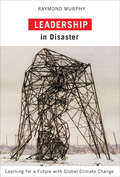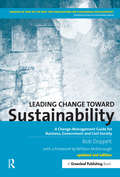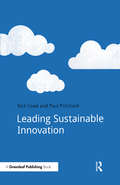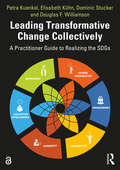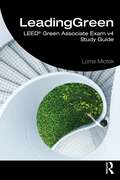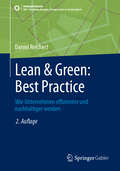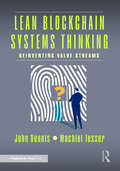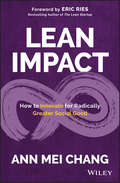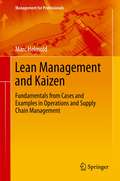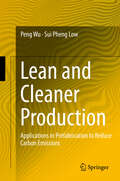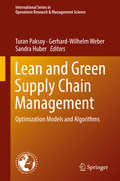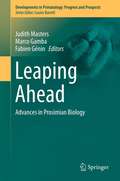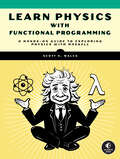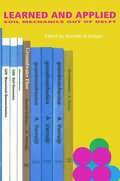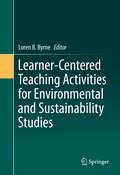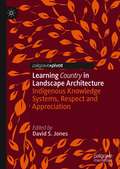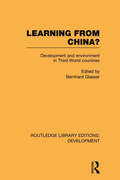- Table View
- List View
Leadership in Disaster: Learning for a Future with Global Climate Change
by Raymond MurphyMurphy explores whether technological development inadvertently constructed new vulnerabilities, thereby manufacturing a natural disaster. As the extreme weather in the ice storm may foreshadow what will occur with global warming, Leadership in Disaster also explores the politics, economics, ethics, and cultural predispositions involved in climate change, investigating how modern societies create both the risks they assume are acceptable and the burden of managing them. An innovative comparison with Amish communities, where the same extreme weather had trivial consequences, is instructive for avoiding future socio-economic catastrophes.
Leading Beyond Sustainability: Six Aspirations for a Brighter Future
by Clive WilsonThe 2020s present a decade of unprecedented disruption. We have now reached a point where people are overwhelmed and numb to the ever-present news of threat after threat, and challenge after challenge. It’s time for leaders to tell a different story of six powerful aspirations – connection, vitality, peace, abundance, opportunity and wisdom. This is a vision "beyond sustainability", to inspire organisations and people to bring the best of who they are into service of the brighter future that is already emerging.Alongside the obvious disruptive challenges of climate change, wars and the pandemic, technology has evolved at a blistering pace. Through technological advances in five sectors – energy, transport, materials, food and manufacturing – we are already transforming the world as we know it. The book seeks to give readers the confidence that there is real hope for a brighter future for our world using these developments and other innovations.The text is supported by inspiring case studies of people and organisations who are already doing amazing things. Crucially, the book highlights the many ways that leaders and organisations can contribute to a better world and encourages dialogue between organisations and people who might not naturally connect. It describes 12 archetypes in organisations that must collaborate in teams to deliver solutions. It also emphasises the need for wise leadership and conscious alignment of everyone to our "brighter future".A manifesto for positive change, this is the perfect book to help turn the UN Sustainable Development Goals into action and to envisage a positive future for leaders at every level in organisations.
Leading Change toward Sustainability: A Change-Management Guide for Business, Government and Civil Society
by Bob DoppeltAs the world struggles to cope with the growing threat of a global carbon crisis, Doppelt has revised one of the best books ever written about change management, leadership and sustainability to focus on de-carbonisation. Doppelt's research, presented in this hugely readable book, demystify the sustainability-change process by providing a theoretical framework and a methodology that managers can use to successfully transform their organisations to embrace sustainable development. Filled with case examples, interviews and checklists on how to move corporate and governmental cultures toward sustainability, the book argues that the key factors that facilitate change appear in the successful efforts at companies such as AstraZeneca, Nike, Starbucks, IKEA, Chiquita, Interface, Swisscom and Norm Thompson and in governmental efforts such as those in the Netherlands and Santa Monica in California. For these and other cutting-edge organisations, leading change is a philosophy for success. Leading Change toward Sustainability has been used by change leaders around the world to guide their internal global warming and sustainability organisational change initiatives. This new edition is essential reading for leaders from all types of organisations.
Leading For Regeneration: Going Beyond Sustainability in Business Education, and Community
by John HardmanThis book presents the regenerative leadership framework that has emerged from doctoral research and consulting work with successful sustainability leaders and their organizations in business, education, and community. The framework synthesizes the levels of awareness, the leadership styles and behaviours, and the organizational arrangements that correlate most significantly across these domains. Most importantly, the overwhelming majority of the leaders in this work agree that individual and collective consciousness development is critical to transforming the culture of organizations for sustainability and beyond. The term regenerative has not been chosen arbitrarily, but to provide an alternative to the notion of sustainability, which many of the leaders featured here indicate has become insufficient to describe what needs to be done, economically, socially, and environmentally, if we are to ensure a flourishing world for present and future generations. This work in turn has led to the development of the Regenerative Capacity Index (RCI), a tool designed to assess an organization’s readiness to engage in regenerative practice. From this evaluation of an organization’s regenerative capacity, it becomes possible to design a strategy for regeneration that considers all levels of its environmental, social, and economic impact, both internally and externally, in the local and global community. Among its major findings, the book argues that the more evolved sustainability leaders are becoming increasingly dissatisfied with the construct of sustainability, and indicate the need for a profound cultural shift towards regenerative human systems. In this framework, regenerative organizations are driven by a sense higher purpose, and leadership is exercised horizontally and collaboratively. Leaders and followers engage in generative conversations to create desirable futures which are then ‘backcasted’ to eliminate unanticipated consequences. Throughout, leaders emphasize the critical importance of engaging in personal and collective consciousness development or "inner work" in order to make regenerative practices possible.
Leading Sustainable Innovation
by Paul Pritchard Nick CoadSustainability will play an increasingly key role in the innovation process within businesses. Leading companies are already integrating these agendas, and preparing their sustainability executives to take the lead. This book demonstrates why sustainability requires innovation; explains how this opportunity can be grasped by sustainability executives; outlines the skills they will need to learn to lead on sustainable innovation; and outlines key trends in sustainable innovation and in managing innovation. Coad and Pritchard provide an overview of mainstream innovation, and draw out common characteristics of successful programmes, such as a corporate culture whose systems promote innovation. They highlight developments such as mobile technology, social media and collaborative consumption which transform the way consumers interact with companies. Viewed alongside emerging ideas on sustainability, such as the circular economy, this points to a clear need for a new set of innovation skills. Companies will face challenges in realizing these opportunities, in particular the development requirements for sustainability executives and broader organizational learning. This book is for companies who want to take advantage, and the sustainability executives who will be leading the way.
Leading Sustainable Innovation: A Roadmap for Technical Environments
by Dr Jo NorthLeading Sustainable Innovation shows how to deliver eco-innovation within technical environments. It is tailored to support innovation leaders and managers in fields such as transport, engineering, infrastructure, energy, utilities and sciences.This book offers practical methodologies, tools, frameworks and actionable steps that readers can implement to create lasting sustainable change for their projects and programs. Through following a step-by-step process, readers will craft a comprehensive roadmap for sustainable innovation, customized for any team or organization. It is aligned with the United Nations Sustainable Development Goals.Leading Sustainable Innovation examines multiple drivers of sustainable innovation, such as innovation strategies, state-of-the-art technologies, circular solutions and organizational factors necessary for success. It emphasizes distinguishing good ideas from weak ones and provides guidance on building a sustainable innovation culture. It features real-world, global examples and case studies such as the Microsoft Sustainable Datacenters (global), the Sellafield Nuclear Power Station Decommissioning (UK), Wunsiedel (Germany), Clean Path (New York), Roads and Transport Authority (Dubai) and Agriphotovoltaic Assets (China), enabling readers to learn valuable lessons from adjacent industries.
Leading Sustainably: The Path to Sustainable Business and How the SDGs Changed Everything
by Trista Bridges Donald EubankThe business world is at an important crossroads. The age of the stakeholder is rapidly superseding that of the shareholder as climate change and political and societal shifts upend years of seeming prosperity. To move past this agitated age, business and society must learn to lead sustainably by putting purpose on equal footing with profit. The first step is understanding what’s meant by sustainability and how it offers an opportunity for both business and society. Inspired by the launch of the 2030 United Nations Sustainable Development Goals (SDGs), the book captures the ideas of more than 100 change makers from around the world about how business is putting sustainability at the core of strategy to survive, thrive, and realign its interests with society’s. Leading Sustainably looks at how sustainability has evolved in a business context, offering powerful insights, key facts, and guidance on building sustainability capability within companies, measuring and managing impact, sustainable finance’s transformation, and other topics critical to aligning businesses’ central activities with sustainable principles. The book introduces five vignettes profiling best-in-class companies that were sustainable from the start and international case studies on business sustainability efforts, spanning industries from hospitality to waste management, fashion, finance, and more. Finally, Bridges and Eubank provide frameworks and in-depth direction firms can leverage when accelerating their transition to more sustainable business models. The book is a perfect guide for mid-level to senior managers seeking to understand this fast-changing business environment, how to factor sustainability into their decision-making, and why the SDGs changed everything.
Leading Transformative Change Collectively: A Practitioner Guide to Realizing the SDGs
by Petra Kuenkel Dominic Stucker Elisabeth Kuhn Douglas F. WilliamsonThis book directly helps decision-makers and change agents in companies, NGOs, and government bodies become more proficient in transformative, collaborative change in realizing the SDGs. This practitioner’s handbook translates a systemic – and enlivening – approach to collaboration into day-to-day work and management. It connects the emerging practice of multi-stakeholder collaboration to easily understandable models, tools, and cases. Numerous, concrete cases not only bring this methodology to life, but also help identify the challenges and avoid common mistakes. The book can be used as a guide to apply a breakthrough approach for navigating the complexity of stakeholder systems, designing results-oriented process architectures, ensuring the success of cross-sector change initiatives, and enlivening collaboration ecosystems for SDG implementation. It is designed to enhance high quality stakeholder engagement, dialogue, and collaboration. A must-read, the book sets a new standard for the collaborative implementation of Agenda 2030 and is a foundational guide for leading sustainability transformations collectively to achieve climate change mitigation, social integration, equitable value chains, and broad sustainability challenges.
Leading with Integrity: Creating Positive Change in Organizations
by Michael SmithThanks to global news and social media, we are the most informed and socially conscious generation in history. But what are the sources of inner inspiration that guide our daily conduct and motivations in the workplace? Far from the old Machiavellian dictum that "the ends justify the means", the reverse is often the case: the means determine the ends. This book presents the stories of business leaders who have aimed to build trust in the economy, and have delivered value through integrity, cooperation, stewardship, purpose and sustainability. It proposes the eight Cs of trust which can define the culture of organizations: contracts, covenants, competences, character, conscience, conviction, courage and change. The book makes the clear link between personal decision-making and global outcomes and demonstrates how positive decision-making can lead to change inside organizations and beyond.
Leading with Love: Rehumanising the Workplace
by Karen Blakeley Chris BlakeleyAs business becomes more automated, power more concentrated, and the forces of competition and consumption seem to dominate our lives, we are in danger of losing what it is to be human. Work for many can be a soulless activity, creating feelings of disempowerment, alienation, and depression. Learning to lead with love is a counterforce to the instrumentalisation of the person. This book presents original research based on leaders who were nominated by their people for leading with love. It shows how they learned to lead with love for the benefit of themselves, their organisations, and their people. It shows that leading with love is something that is practised by leaders who are more emotionally, morally, and spiritually mature. Leading with love is a sign of psychological maturity, whilst leading with fear is a sign of hindered emotional and spiritual development. Based on this research, this book presents a simple framework to help leaders who wish to develop their psychological maturity and apply practices which will enable them to successfully lead with love.
LeadingGreen: LEED® Green Associate Exam v4 Study Guide
by Lorne MlotekLeadingGreen: LEED® Green Associate Exam v4 Study Guide brings together a concise introduction to the core concepts behind the LEED green building rating system with efficient, effective test preparation for the LEED® Green Associate Exam. The guide provides an essential foundation in principles of sustainable design and construction for students and professionals in the areas of architecture, engineering, construction, real estate development, urban planning, and environmental policy. If you are interested in passing the LEED® Green Associate Exam, this is the right place to start. The background, objectives, and evolution of green building standards – as well as what actually goes into a LEED building – are covered in a clear and straightforward manner. Tailored to precise exam expectations, the guide breaks down the key LEED categories one credit at a time. Drawing upon the author’s extensive experience as a LEED educator for universities and professional firms around the world, the guide includes proven tips and tricks that have helped over 10,000 people pass the Green Associate Exam. An ideal resource for self-study, LeadingGreen: LEED® Green Associate Exam v4 Study Guide will benefit readers from all built environment professions in which LEED credentials are an asset.
Leaf Litter Critters
by Leslie BulionTake a poetic tour through the duff and get the dirt on the tiny, fascinating critters that live there.For all the kids who can't resist turning over a rock, science poetry maven Leslie Bulion presents nineteen lively ecological poems in a variety of verse forms about the "brown food web" and the creatures that live there—from bacteria and rove beetles to mushrooms and millipedes, and all of the other busy recyclers in between. Illustrator Robert Meganck adds to the fun with humorous and vivid, yet scientifically detailed, artwork. Science notes run throughout for added context, and thorough back matter includes a glossary, poetry notes, hands-on investigations, and other resources for cross-curricular learning.
Lean & Green: Wie Unternehmen effizienter und nachhaltiger werden (SDG - Forschung, Konzepte, Lösungsansätze zur Nachhaltigkeit)
by Daniel ReichertDieses Buch präsentiert Erfolgsrezepte führender europäischer Unternehmen, die durch Lean-Management und Nachhaltigkeitsstrategien Wettbewerbsvorteile erzielen. Die vorgestellten Unternehmen, Teilnehmer des Lean & Green Management Awards, demonstrieren, wie Effizienzsteigerung und ökologische sowie soziale Verantwortung Hand in Hand gehen können.In Zeiten wachsender Unsicherheiten, geprägt durch geopolitische Spannungen, regulatorische Anforderungen und Rohstoffknappheit, wird nachhaltige Wertschöpfung zum entscheidenden Erfolgsfaktor. Unternehmen, die Ressourceneffizienz systematisch steigern, senken nicht nur Kosten, sondern erhöhen ihre Widerstandsfähigkeit und Zukunftsfähigkeit.Das Konzept Lean & Green kombiniert schlanke, effiziente Prozesse mit Umwelt- und Nachhaltigkeitsaspekten, um Nachhaltigkeit messbar und operativ wirksam zu machen. Der Autor zeigt, wie Unternehmen Lean-Methoden gezielt für mehr Nachhaltigkeit nutzen können, um wirtschaftlichen Erfolg und ökologische Verantwortung zu vereinen. Praktische Anleitungen und Best-Practice-Beispiele bieten wertvolle Einblicke für Unternehmen, die ihre Wettbewerbsfähigkeit langfristig sichern wollen.
Lean Blockchain Systems Thinking: Reinventing Value Streams
by John Dennis Machiel TesserThis book brilliantly illustrates how blockchain and Web3 are revolutionizing value exchange in society. Blockchain technology sets new standards for transparency, provenance, and traceability, benefiting every stakeholder across the value chain in an interoperable manner. The technology fundamentally transforms industries, verticals, and functions within organizations, enabling decentralized identity, asset tokenization, governance, and enhanced privacy. This book offers a deep yet accessible guide to navigating this new paradigm.—Alejandro Acuña Rodríguez, Blockchain Infrastructure Specialist, CrossmintLean Thinking has its roots in ideas developed for process improvement in the 1900s. Systems Thinking was discussed as far back as the 1950s. Blockchain technology is based on work that started in the 1990s and was implemented soon after Satoshi Nakamoto published his Bitcoin whitepaper in 2009. Together, these three components—Lean, Blockchain, and Systems Thinking—provide a revolutionary force in process management efficiency and effectiveness.This book provides a perspective on the advantages of blockchain technology that is rarely covered in business books as well as specialist blockchain-related content. The focus has been the use of Cryptocurrencies as a store of financial value and as an instrument of speculation, like the stock market. This book shows that blockchain, together with Lean and Systems Thinking can provide multiple advantages for societies and the environment. It can be used effectively to meet sustainable development goals (SDGs).Readers will appreciate that blockchain within Lean practices and Systems Thinking opens opportunities for fundamental organizational transformation, improved strategic decision-making, increased interoperability, and a fairer, more sustainable, and less wasteful world. This book clarifies how the integration of blockchain technology as an organizational concept integrates Lean principles and Systems Thinking. This brings a transformative shift in process design, increasing productivity while minimizing waste across sectors such as industry, public services, governance, supply chains, and social frameworks.
Lean Impact: How to Innovate for Radically Greater Social Good
by Ann Mei ChangDespite enormous investments of time and money, are we making a dent on the social and environmental challenges of our time? What if we could exponentially increase our impact? Around the world, a new generation is looking beyond greater profits, for meaningful purpose. But, unlike business, few social interventions have achieved significant impact at scale. Inspired by the modern innovation practices, popularized by bestseller The Lean Startup, that have fueled technology breakthroughs touching every aspect of our lives, Lean Impact turns our attention to a new goal - radically greater social good. Social change is far more complicated than building a new app. It requires more listening, more care, and more stakeholders. To make a lasting difference, solutions must be embraced by beneficiaries, address root causes, and include an engine that can accelerate growth to reach the scale of the need. Lean Impact offers bold ideas to reach audacious goals through customer insight, rapid experimentation and iteration, and a relentless pursuit of impact. Ann Mei Chang brings a unique perspective from across sectors, from her years as a tech executive in Silicon Valley to her most recent experience as the Chief Innovation Officer at USAID. She vividly illustrates the book with real stories from interviews with over 200 organizations across the US and around the world. Whether you are a nonprofit, social enterprise, triple bottom line company, foundation, government agency, philanthropist, impact investor, or simply donate your time and money, Lean Impact is an essential guide to maximizing social impact and scale.
Lean Management and Kaizen: Fundamentals from Cases and Examples in Operations and Supply Chain Management (Management for Professionals)
by Marc HelmoldThe book provides a holistic and practical approach to lean management throughout the business value chain. The lean management framework and tools demonstrate the optimal design and use of methods, tools and principles for companies and organisations. The author describes comprehensively how lean management enables companies to concentrate on value-adding activities and processes to achieve a long-term, sustainable competitive advantage. A wealth of best practices, industry examples and case studies are used to reveal the diversity and opportunities of lean management methodologies, methods and principles. Moreover, the book shows how lean management principles are ultimately applied in industries like automotive, healthcare, education and services industries.
Lean and Cleaner Production
by Sui Pheng Low Peng WuThis book explains how in moving towards Cleaner Production, the Lean Production Philosophy can be applied to reduce carbon emissions in prefabrication - one major source of the Greenhouse Gas (GHG) emissions which contribute to global climate change. This book examines theories and principles in the Lean Production Philosophy to develop situation-based carbon reduction strategies for precast concrete manufacturers and contractors in terms of Site layout, Supply Chain, Production, Stocks and Installation Management. It presents the empirical findings of surveys and case studies with managers and professionals working for precasters and contractors in Singapore, findings which provide good practical guidance for precast concrete manufacturers and contractors to achieve low carbon emissions and to perform better in many sustainability-based rating systems, such as the Singapore Green Labelling Scheme and the Building and Construction Authority (BCA) Green Mark Scheme.
Lean and Green Supply Chain Management: Optimization Models and Algorithms (International Series in Operations Research & Management Science #273)
by Gerhard-Wilhelm Weber Turan Paksoy Sandra HuberThis book presents the latest developments in optimization and optimal control models; exact, approximate and hybrid methods; and their applications in lean and green supply chains. It examines supply chain network design and modeling, closed loop supply chains, and lean, green, resilient and agile or responsive networks, and also discusses corporate social responsibility and occupational health and safety. It particularly focuses on supply chain management under uncertainty – employing stochastic or nonlinear modeling, simulation based studies and optimization – multi-criteria decision-making and applications of fuzzy set theory, and covers various aspects of supply chain management such as risk management, supplier selection or the design of automated warehouses. Lastly, using experimental applications and practical case studies, it shows the impact of lean and green applications on vehicle/fleet management and operations management.
Leaping Ahead
by Fabien Génin Russell Tuttle Marco Gamba Judith MastersLeaping Ahead: Advances in Prosimian Biology presents a summary of the state of prosimian biology as we move into the second decade of the 21st century. The book covers a wide range of topics, from assessments of diversity and evolutionary scenarios, through ecophysiology, cognition, behavioral and sensory ecology, to the conservation and survival prospects of this extraordinary and diverse group of mammals. The collection was inspired by an international conference in Ithala, KwaZulu-Natal, South Africa in 2007, where prosimian biologists gathered from Canada, Finland, France, Germany, India, Italy, Japan, Madagascar, South Africa, Tanzania, the United Kingdom, and the United States of America. The meeting reverberated with the passion prosimian researchers feel for their study subjects and with their deep concern for the future of prosimians in the face of ongoing habitat destruction and the burgeoning threat of bushmeat hunting. Chapters for this volume were contributed by researchers from across the globe; they attest to the diversity, vibrancy and rapid growth of prosimian biology, and to the intellectual advances that have revolutionized this field in recent years. Since its earliest beginnings, prosimian research and its resultant literature have had a strong francophone component, and researchers in many prosimian habitat countries are more comfortable reading and writing in French rather than English. French summaries of all chapters have been included. The volume is targeted at researchers, both those entering the field and established scientists, who have an interest in the biology of primates and small mammals. It is also aimed at conservation biologists seeking a deeper understanding of the faunas and conservation developments in Africa, Madagascar and Southeast Asia, and anyone who has an interest in discovering the true diversity of our order, the Primates.
Learn Physics with Functional Programming: A Hands-on Guide to Exploring Physics with Haskell
by Scott N. WalckDeepen your understanding of physics by learning to use the Haskell functional programming language.Learn Physics with Functional Programming is your key to unlocking the mysteries of theoretical physics by coding the underlying math in Haskell.You&’ll use Haskell&’s type system to check that your code makes sense as you deepen your understanding of Newtonian mechanics and electromagnetic theory, including how to describe and calculate electric and magnetic fields.As you work your way through the book&’s numerous examples and exercises, you&’ll learn how to:Encode vectors, derivatives, integrals, scalar fields, vector fields, and differential equationsExpress fundamental physical principles using the logic of Haskell&’s type system to clarify Newton&’s second law, Coulomb&’s law, the Biot-Savart law, and the Maxwell equationsUse higher-order functions to express numerical integration and approximation methods, such as the Euler method and the finite-difference time-domain (FDTD) methodCreate graphs, models, and animations of physical scenarios like colliding billiard balls, waves in a guitar string, and a proton in a magnetic fieldWhether you&’re using this book as a core textbook for a computational physics course or for self-study, Learn Physics with Functional Programming will teach you how to use the power of functional programming to explore the beautiful ideas of theoretical physics.
Learned and Applied Soil Mechanics: A tribute to Dr Arnold Verruijt, TUD
by Frans B.J. Barends Paola M.P.C. SteijgerA tribute to Professor Dr Arnold Verruijt, on the occasion of his retirement as professor in soil mechanics at the Technical University of Delft, this book is divided into five chapters covering: groundwater flow, consolidation, numerical methods, geodynamics and geostatics.
Learner-Centered Teaching Activities for Environmental and Sustainability Studies
by Loren B. ByrneLearner-centered teaching is apedagogical approach that emphasizes the roles of students as participants inand drivers of their own learning. Learner-centered teaching activities gobeyond traditional lecturing by helping students construct their ownunderstanding of information, develop skills via hands-on engagement, andencourage personal reflection through metacognitive tasks. In addition,learner-centered classroom approaches may challenge students' preconceivednotions and expand their thinking by confronting them with thought-provokingstatements, tasks or scenarios that cause them to pay closer attention andcognitively "see" a topic from new perspectives. Many types of pedagogy fallunder the umbrella of learner-centered teaching including laboratory work,group discussions, service and project-based learning, and student-ledresearch, among others. Unfortunately, it is often not possible to use some ofthese valuable methods in all course situations given constraints of money,space, instructor expertise, class-meeting and instructor preparation time, andthe availability of prepared lesson plans and material. Thus, a major challengefor many instructors is how to integrate learner-centered activities widelyinto their courses. The broad goal of this volume is to helpadvance environmental education practices that help increase students'environmental literacy. Having a diverse collection of learner-centeredteaching activities is especially useful for helping students develop theirenvironmental literacy because such approaches can help them connect morepersonally with the material thus increasing the chances for altering theaffective and behavioral dimensions of their environmental literacy. Thisvolume differentiates itself from others by providing a unique and diversecollection of classroom activities that can help students develop theirknowledge, skills and personal views about many contemporary environmental andsustainability issues.
Learning Country in Landscape Architecture: Indigenous Knowledge Systems, Respect and Appreciation
by David S. JonesThis book strategically focuses upon the feasibility of positioning Indigenous Knowledge Systems into tertiary built environment education and research in Australia. Australian tertiary education has little engaged with Indigenous peoples and their Indigenous Knowledge Systems, and the respectful translation of their Indigenous Knowledge Systems into tertiary education learning. In contrast, while there has been a dearth of discussion and research on this topic pertaining to the tertiary sector, the secondary school sector has passionately pursued this topic. There is an uneasiness by the tertiary sector to engage in this realm, overwhelmed already by the imperatives of the Commonwealth’s ‘Closing the Gap’ initiative to advance Aboriginal and Torres Strait Islander tertiary education successes and appointments of Indigenous academics. As a consequence, the teaching of Indigenous Knowledge Systems relevant to professional disciplines, particularly landscape architecture where it is most apt, is overlooked and similarly little addressed in the relevant professional institute education accreditation standards.
Learning From China?: Development and Environment in Third World Countries (Routledge Library Editions: Development)
by Bernhard GlaeserFirst published in 1987, this volume was written to shed some light upon the nature and environmental consequences and wider relevance of development strategies in the Peoples’ Republic of China. It covers industrialisation, food production, energy use and landscape and settlement planning. The Chinese "autocentred" strategy is assessed from both the developmental and the environmental viewpoints. Decision-making processes and the opportunities to implement environmental policy in other parts of the developing world are analysed and the volume concludes with the view that benefits to other countries are likely to arise out of increased co-operation and exchange with China, although the Chinese model is by no means a panacea. All students and researchers interested in either environmental or developmental issues will find this book to be a substantial and enlightening contribution to literature.
Learning From the Global Financial Crisis: Creatively, Reliably, and Sustainably (High Reliability and Crisis Management)
by Paul Shrivastava and Matt StatlerThis book is motivated by the simple hope that the cloud of the global financial crisis may yet have a silver lining—that political leaders, economists, and management scholars might seize this opportunity to reflect critically on the assumptions, practices, and infrastructures that have precipitated the crisis and to imagine and create new forms of organization that sustainably enhance the well-being of global stakeholders. The contributors suggest that aesthetic management, high reliability and crisis management, and sustainability science have much to contribute to the resolution of the collapse that we've witnessed, and to providing enduring lessons for how to structure the institutions of the future. Learning From the Global Financial Crisis devotes a section to each of these areas, offering full-length chapters which explore key issues in depth, as well as shorter commentaries that focus on practical considerations. The chapters progress from micro-level issues that pertain to individuals and teams who act creatively; to the meso-level issues that pertain to the structures, practices, and processes; to the macro-level issues that pertain to the interdependent, ecological systems. Together, the contributions emphasize the importance of developing holistic responses to the financial crisis. The result is a volume that casts new light on traditional economic and managerial theories and policies and provides fresh ideas to a new generation of scholars and practitioners.
